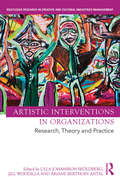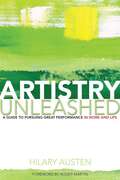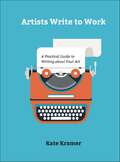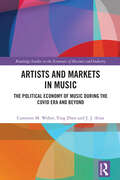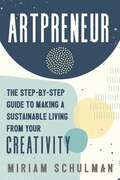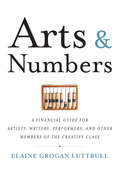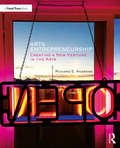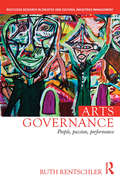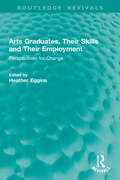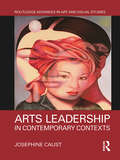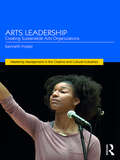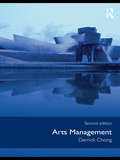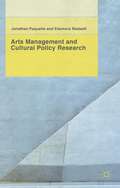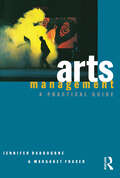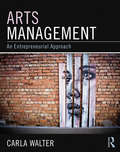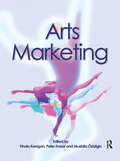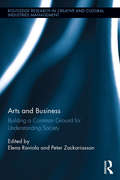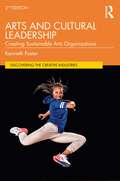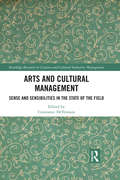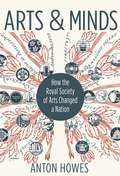- Table View
- List View
Artistic Interventions in Organizations: Research, Theory and Practice (Routledge Research in Creative and Cultural Industries Management)
by Ariane Berthoin Antal Ulla Johansson Sköldberg Jill WoodillaArtistic intervention, where the world of the arts is brought into organizations, has increasingly become a research field in itself with strong links to both creativity and innovation. Opportunities for the arts to interact with public and private organizations occur worldwide, but during the last decade artistic interventions have received growing attention in both practice and research. This book is the first comprehensive attempt to map the development of the field and provides an international overview of the area of artistic interventions and their impact on organizations from different perspectives, ranging from strategic management to organizational development, innovation and organizational learning. Featuring chapters from prominent and emerging scholars, including Nancy J. Adler, Barbara Czarniawska, Lotte Darsø and Alexander Styhre, it places artistic interventions within an international context. The book also offers readers the opportunity to learn from experiences in a varied range of organisations, including newspapers, manufacturing, government, schools, and covers many art-forms, such as music, contemporary dance, painting, photography, and theatre. Using extensive empirical examples, this book is vital reading for researchers and scholars of creativity and cultural industries, as well as innovation, creative entrepreneurship, organizational studies and management.
Artistry Unleashed
by Hilary Austen University of TorontoArtistry Unleashed is about working and living at the edge of what you know and beyond. Surprise, uncertainty, ambiguity, intensity, and change are all disruptive forces that we often avoid or fear. Yet they are the essential origin of both creativity and great performance.Imagine if you could make effective progress with no clear plan or destination in view; if you could achieve excellence without sacrificing creativity; if you could invest passion even as you apply reason and intelligence. Learn how artistry, when allowed to escape studio walls, can help painters, CEOs, athletes, scientists, chefs, and you to achieve these powerful capabilities. Artistry Unleashed provides original and practical tools to transform what we think about artistry's role in professions, in organizations, in education, and, most importantly, in everyday life. Artistry Unleashed reveals the unique features of artistic work in any field: enigmatic problems; qualitative intelligence; cognitive emotions; downstream and upstream learning; and your personal knowledge system.
Artists Labour Market, Cultural Policy and Creative Economy: A Triangular Model in Poland (Routledge Focus on Economics and Finance)
by Dorota Ilczuk Anna Karpińska Emilia CholewickaFocusing on artists and creators, this shortform book analyses the labour market in the creative economy in the context of cultural policies.Based on a series of studies involving Polish artists spanning 10 years, the book identifies the key factors needed to understand contemporary labour markets in the creative and cultural sectors worldwide. The authors integrate artists’ perspectives to present truly rounded evidence, shedding light on the applicational perspective of the research findings.Illuminating the socioeconomic status of artists in Poland, this book is essential reading for researchers interested in cultural policy and the creative economy, as well as work and labour studies more broadly. It will also be of interest to practitioners in the creative and cultural industries.
Artists Write to Work: A Practical Guide to Writing about Your Art
by Kate KramerWriting and research strategies for documents every artist must craft: letters, applications, wall text, etc.Welcoming and effective, spells out clear connections between the writing process and creative practiceDestined to become an important addition to the libraries of art students, educators, and artists
Artists and Artistic Production in Ancient Greece
by Kristen Seaman Peter SchultzGreek artists and architects were important social agents who played significant roles in the social, cultural, and economic life of the ancient Greek world. In Artists and Artistic Production in Ancient Greece, art historians, archaeologists, and historians explore the roles and impacts of artists and craftsmen in ancient Greek society. The contributing authors draw upon artistic, architectural, literary, epigraphical, and historical evidence to discuss a range of artists, architects, artistic media, and regions. They refer to historiography and modern theory, taking stock of the past while offering some new directions for future research. Incorporating a variety of methodological approaches and making use of often-neglected evidence, Artists and Artistic Production in Ancient Greece re-examines many long-held ideas and provides a deeper understanding of particular artists and architects, their works, and their social agency.
Artists and Markets in Music: The Political Economy of Music During the Covid Era and Beyond (Routledge Studies in the Economics of Business and Industry)
by Cameron M. Weber Ying Zhen J.J. AriasThis monograph is an innovative examination of the political economy of music. It integrates original economic theories and empirical research to shed light on the economic and social forces shaping music and society today. Interactive relationships, such as the importance of entrepreneurship, serendipity and authenticity, will be explored in artist subjective determinations of success. In particular, this book deeply explores the mental health of musicians and "creative destruction" during the covid era, copyrights in music markets and an evaluation of the importance of entrepreneurship and brand marketing in the life of musical artists. The monograph contributes empirical research to underexplored areas in the cultural economics of music, such as the proposed musical production function by Samuel Cameron (Routledge 2015) and the concept of distinction in cultural production by Pierre Bourdieu (Routledge 1984, 2010) as uniquely applied with examples from the covid era. Readers will benefit from this easy-to-understand interdisciplinary exploration of the music industry with a focus on the United States and the political economy of music during the covid era. Most cultural economics is focused on Europe and Asia, so this emphasis on the United States will be of interest. This book will be a beneficial reference work for researchers and will find an audience among music professionals and artists. Academics and non-academics, experts and novices interested in music and political economy will also find value in Artists and Markets in Music.
Artpreneur: The Step-by-Step Guide to Making a Sustainable Living From Your Creativity
by Miriam SchulmanA step-by-step guide for creatives to transform your passion into a profitable business.Whether you&’re a musician, photographer, painter, writer, dancer, singer, or any other creative with aspirations of making a living from your art, this is the perfect time to turn your creative ideas into a sustainable business. With gatekeepers no longer controlling the market, anyone with a laptop and a dream can make a thriving living from their creativity.This is the definitive sales and marketing playbook for anyone looking to make a living from their art. Each page provides the inspiration and practical steps you need to build a personal brand, overcome starving-artist syndrome, and finally make consistent sales from your art. By combining left-brain traditional marketing methods with the tools you&‘ll build a confident mindset, take charge of your destiny, and create a clear path for success.Miriam Schulman, host of the Inspiration Place podcast, breaks down the five core elements in the &“Passion to Profit&” planning framework to help you develop your art business—so that you can have the time and freedom to do what you love:PROSPECTING: Build an audience of followers who want what you've got and are prepared to pay top dollar.PRODUCTION: Draw attention to your creations by embracing your authenticity.PRODUCTIVITY: Create work-life balance by managing your priorities and setting manageable goals.PROMOTION: Attract collectors in an authentic and non-salesy way.PRICING: Price your art, products, or services based on cutting edge research that explains buyer psychology.After twenty years of selling art as well as coaching other artists, Miriam knows that now is the time to leave the rat race and pursue your highest dreams. Don&’t wait for a sign from the universe to gamble on yourself.
Arts & Numbers
by Elaine Grogan LuttrullThe creative class-artists, actors, writers, musicians, freelancers, dancers, performers, and the like-are known for applying their passion for creative expression to everything they do. Perhaps the one thing that most fills this group with apprehension is the rigid world of numbers. This leads to problems arising from the unconventional financial and business situations of creative professionals, as well as the nonprofit organizations with which they're often affiliated. Finances, budgeting, and business matters can be dreaded, if not outright ignored, by creatives--to the detriment of their artistic pursuits.Author, artist, and CPA Elaine Grogan Luttrull has written Arts & Numbers to help creative professionals find the same confidence in their financial dealings as in their chosen mode of expression. It is an engaging, accessible guide that covers a variety of must-know topics, such as budgeting, cash management, visual charting, taxes, employment, and business etiquette. In a simple, straightforward style, Luttrull draws examples from smooth-flowing narratives depicting common issues within the arts worlds, as well as from her own personal anecdotes. Unlike stuffy textbooks and patronizing business books, Arts & Numbers is a lively and artfully done ally in helping creative professionals plan their present financial situations and secure their futures.
Arts Entrepreneurship: Creating a New Venture in the Arts
by Richard AndrewsArts Entrepreneurship: Creating a New Venture in the Arts provides the essential tools, techniques, and concepts needed to invent, launch, and sustain a business in the creative sector. Building on the reader’s artistic talents and interests, the book provides a practical, action-oriented introduction to the business of art, focusing on product design, organizational planning and assessment, customer identification and marketing, fundraising, legal issues, money management, cultural policy, and career development. It also offers examples, exercises, and references that guide entrepreneurs through the key stages of concept creation, business development, and growth. Special attention is paid to topics such as cultural ventures seeking social impact, the emergence of creative placemaking, the opportunities afforded by novel corporate forms, and the role of contemporary technologies in marketing, fundraising, and operations. A hands-on guide to entrepreneurial success, this book is a valuable resource for students of Arts Entrepreneurship programs, courses, and workshops, as well as for early-stage business founders in the creative sector looking for guidance on how to create and sustain their own successful venture.
Arts Governance: People, Passion, Performance (Routledge Research in Creative and Cultural Industries Management)
by Ruth RentschlerSince the crisis in governance which led to a shortage of capable board members, recent years have seen the emergence of the enterprising arts organisation – a development which has led to the need for new types of board members who have a greater understanding of 'mission, money and merit' within a cultural construct. This innovative book explores the world of the arts board member from the unique perspective of the cultural and creative industries. Using a wide range of research techniques including interviews with board members and stakeholders, board observations and case studies this book provides a rich and deep analysis from inside the boardroom. It provides in-depth insight into the changing pressures on arts boards after the financial crisis, and focuses uniquely on the role of passion on arts boards. Part of the Routledge Research in Creative and Cultural Industries Management series, written specifically for people seeking to develop their careers in cultural and creative management, this book is also for people working in and with arts organisations, in government and non-profit arts organisations. It will also be of interest to academics and researchers working in the wider corporate governance field.
Arts Graduates, Their Skills and Their Employment: Perspectives for Change (Routledge Revivals)
by Heather EgginsOriginally published in 1992, this book was the first to gather together the view of industrialists, teachers and researchers. It focusses on the skills dimension of arts graduates which carry significant implication for all undergraduate programmes. It examines how the humanities and the world of work interact and how the relationship might be shaped in the future as the United Kingdom moved rapidly to a system of mass higher education. This book will be of use to all those responsible for enabling the new graduate of whatever subject to develop their skills and marketability to the full.
Arts Leadership in Contemporary Contexts (Routledge Advances in Art and Visual Studies)
by Josephine CaustThis book explores and critiques different aspects of arts leadership within contemporary contexts. While this is an exploration of ways arts leadership is understood, interpreted and practiced, it is also an acknowledgement of a changing cultural and economic paradigm. Understanding the broader environment for the arts is therefore part of the leadership imperative. This book examines aspects such as individual versus collective leadership, gender, creativity and the influences of stakeholders and culture. While the book provides a theoretical and critical understanding of arts leadership, it also gives examples of arts leadership in practice.
Arts Leadership: Creating Sustainable Arts Organizations (Mastering Management in the Creative and Cultural Industries)
by Kenneth FosterThe contemporary world faces unprecedented upheaval and change forcing institutions of all types to rethink how they are designed and how they must now function if they are to survive into an uncertain future. The performing arts are no exception; in an era of constant change and technological transformation, arts organizations and their leaders face significant organizational challenges if they are to maintain their relevance. Arts Leadership: Creating Sustainable Arts Organizations provides a contemporary overview of the field of arts leadership, focused on the performing arts. It examines what these challenges are, how they are affecting the performing arts and arts organizations in general and proposes creative ways to reimagine, build and lead sustainable arts organizations in this uncharted environment. With a global perspective drawn from his extensive experience advising arts organizations around the world and based on his own work successfully leading important performing arts organizations in the United States, Foster proposes an innovative approach to organizational design, systems, and structures for arts leaders in the 21st century that is based in ecological thinking and the creative process that is intrinsic to the arts. In disrupting conventional arts leadership practice, the book provides an exceptional tool to understand a unique sector, and is essential reading for students and practitioners across the creative and cultural industries.
Arts Management
by Derrick ChongThe second edition of Arts Management has been thoroughly revised to provide an updated, comprehensive overview of this fast-changing subject. Arts managers and students alike are offered a lively, sophisticated insight into the artistic, managerial and social responsibilities necessary for those working in the field. With new cases studies and several new chapters, Derrick Chong takes an interdisciplinary approach in examining some of the main impulses informing discussions on the management of arts and cultural organizations. These are highly charged debates, since arts managers are expected to reconcile managerial, economic and aesthetic objectives. Topics include: arts and the State, with reference to the instrumentalism of the arts and culture business and the arts ownership and control of arts organizations arts consumption and consumers, including audience development and arts marketing managing for excellence and artistic integrity financial investing in the arts, namely fine arts funds and theatre angels philosophies of philanthropy Incorporating a deliberately diverse range of sources, Arts Management is essential reading for students on arts management courses and provides valuable insights for managers already facing the management challenges of this field.
Arts Management and Cultural Policy Research
by Jonathan Paquette Eleonora RedaelliPresenting concepts, knowledge and institutional settings of arts management and cultural policy research, this book builds on two assumptions that are simultaneously propositions. The first is that arts management research and cultural policy research evolve in an academic space that is very loosely connected, but nevertheless federated. The second is that we evolve in a field where there is a greater diversity of knowledge producers than it is often assumed. Practicing outside academia, many arts managers, policymakers, advocates, and other professionals still connect and mediate knowledge in spaces that are interconnected, and perhaps even more integrated than we would readily admit. This book offers a map, a representation of the concepts and spaces of knowledge production in the field. It constitutes an excellent introduction to students, and scholars and practitioners will find in it a renewed representation of the field and the seeds of an intellectual debate on our research community.
Arts Management: A practical guide
by Jennifer RadbourneArts management is no longer a resting place for enthusiastic amateurs or artists with insufficient talent to make the big time. Rather, it is increasingly being recognised as a profession with a set of skills which need to be learnt.Arts Management is a comprehensive handbook for arts administrators working in all art forms and in organisations ranging from small community co-operatives to large national flagships. With extensive Australian case studies, it covers cultural policy, fundraising, legal issues, marketing and public relations, managing people and money and event management.Arts Management is an essential reference for practising arts administrators and students.
Arts Management: An entrepreneurial approach
by Carla WalterArts Management is designed as an upper division undergraduate and graduate level text that covers the principles of arts management. It is the most comprehensive, up to date, and technologically advanced textbook on arts management on the market. While the book does include the background necessary for understanding the global arts marketplace, it assumes that cultural fine arts come to fruition through entrepreneurial processes, and that cultural fine arts organizations have to be entrepreneurial to thrive. Many cases and examples of successful arts organizations from the Unites States and abroad appear in every chapter. A singular strength of Arts Management is the author's skilful use of in-text tools to facilitate reader interest and engagement. These include learning objectives, chapter summaries, discussion questions and exercises, case studies, and numerous examples and cultural spotlights. Online instructor's materials with PowerPoints are available to adopters.
Arts Management: Uniting Arts And Audiences In The 21st Century
by Ellen RosewallDesigned for students and practitioners with little experience in not-for-profit management, Arts Management provides an indispensable guide to the theory and practice of managing arts and cultural organizations. This concise text engages readers with case studies and critical-thinking exercises that will develop their ability to adapt to a changing industry. From governance and human resources to program development, financial management, and marketing, Arts Management addresses the unique atmosphere of managing the arts today. It meets the standards of the AAAE (Association of Arts Administration Educators) guaranteeing that both current and future practitioners will be prepared to meet the challenges of managing today's arts organizations.
Arts Marketing
by Finola Kerrigan Peter Fraser Mustafa OzbilginArts Marketing focuses on a variety of sectors within the arts and addresses the way in which marketing principles are applied within these, outlining both the similarities and the differences that occur. Relating policy to practice, this contributed text demonstrates the most effective means of marketing in specific areas of the arts, with each chapter having been written by a specialist in the field. Although primarily focusing on the UK market, the subject has global relevance and appeal, and policy is evaluated on national, European and supranational levels. Specialist topics dealt with range from the marketing of the theatre, opera, and museums, through to the film industry and popular music.
Arts Marketing Insights
by Philip Kotler Joanne Scheff BernsteinAudience behavior began to shift dramatically in the mid 1990s. Since then, people have become more spontaneous in purchasing tickets and increasingly prefer selecting specific programs to attend rather than buying a subscription series. Arts attenders also expect more responsive customer service than ever before. Because of these and other factors, many audience development strategies that sustained nonprofit arts organizations in the past are no longer dependable and performing arts marketers face many new challenges in their efforts to build and retain their audiences. Arts organizations must learn how to be relevant to the changing lifestyles, needs, interests, and preferences of their current and potential audiences.Arts Marketing Insights offers managers, board members, professors, and students of arts management the ideas and information they need to market effectively and efficiently to customers today and into the future. In this book, Joanne Scheff Bernstein helps readers to understand performing arts audiences, conduct research, and provide excellent customer service. She demonstrates that arts organizations can benefit by expanding the meaning of "valuable customer" to include single-ticket buyers. She offers guidance on long-range marketing planning and helps readers understand how to leverage the Internet and e-mail as powerful marketing channels. Bernstein presents vivid case studies and examples that illustrate her strategic principles in action from organizations large and small in the United States, Great Britain, Australia, and other countries.
Arts Property and Hotel
by Arthur I SegelJulio Martinez finds himself as one of the owners of the Arts Hotel Project in Barcelona, Spain. The 455-room hotel is managed by the Ritz Carlton and is in a 44-story tower along Barcelona's beachfront. Julio needs to figure out a strategy to maximize his investment, including a negotiation of the Ritz's operating agreement. Includes color exhibits.
Arts and Business: Building a Common Ground for Understanding Society (Routledge Research in the Creative and Cultural Industries #6)
by Peter Zackariasson Elena RaviolaArts and Business aims at bringing arts and business scholars together in a dialogue about a number of key topics that today form different understandings in the two disciplines. Arts and business are, many times, positioned as opposites. Where one is providing symbolic and aesthetic immersion, the other is creating goods for a market and markets for a good. They often deal and struggle with the same issues, framing it differently and finding different solutions. This book has the potential of offering both critical theoretical and empirical understanding of these subjects and guiding further exploration and research into this field. Although this dichotomy has a well-documented existence, it is reconstructed through the writing-out of business in art and vice versa. This edited volume distinguishes itself from other writings aimed at closing the gap between art and business, as it does not have a firm standpoint in one of these fields, but treating them as symmetrical and equal. The belief that by giving art and business an equal weight, the editors also create the opportunity to communicate to a wider audience and construct a path forward for art and business to coexist.
Arts and Cultural Leadership: Creating Sustainable Arts Organizations (Discovering the Creative Industries)
by Kenneth FosterThis textbook provides an expert overview of the challenge of arts and cultural leadership in the contemporary world. Grounded in theories of sustainability and with a renewed global focus for this second edition, the author’s insights from contemporary arts organizations facilitate meaningful student comprehension. Drawing on the work of practitioners and theorists in the fields of philosophy, biology, and ecology as well as the arts, Foster proposes a rethinking of organizational design, strategy, and structure that is based on ecological concepts and the creative process that is intrinsic to the arts rather than the conventional business model that currently prevails, particularly in western arts and culture organizations. He contests conventional thinking about arts administration and management and urges arts leaders to foreground innovation as they reimagine their organizations for a world unlike any other. New sections include an enhanced theoretical discussion as well as new material on business models, strategy, and organizational design and practice. Applicable to any arts organization, the entrepreneurial focus is especially relevant in the aftermath of the global pandemic, the ongoing climate crisis, and the quest for democracy and social justice. This updated edition will be a valuable resource both for present-day arts and cultural leaders who are working to adapt to the current environment as well as students and future leaders who aspire to make change in the world through arts and cultural leadership.
Arts and Cultural Management: Sense and Sensibilities in the State of the Field (Routledge Research in Creative and Cultural Industries Management)
by Constance DeVereauxArts and Cultural Management: Sense and Sensibilities in the State of the Field opens a conversation that is much needed for anyone identifying arts management or cultural management as primary areas of research, teaching, or practice. In the evolution of any field arises the need for scrutiny, reflection, and critique, as well as to display the advancements and diversity in approaches and thinking that contribute to a discipline’s forward progression. While no one volume could encompass all that a discipline is or should be, a representational snapshot serves as a valuable benchmark. This book is addressed to those who operate as researchers, scholars, and practitioners of arts and cultural management. Driven by concerns about quality of life, globalization, development of economies, education of youth, the increasing mobility of cultural groups, and many other significant issues of the twenty-first century, governments and individuals have increasingly turned to arts and culture as means of mitigating or resolving tough policy issues. For their growth, arts and culture sectors depend on people in positions of leadership and management who play a significant role in the creation, production, exhibition, dissemination, interpretation, and evaluation of arts and culture experiences for publics and policies. Less than a century old as a formal field of inquiry, however, arts and cultural management has been in flux since its inception. What is arts and cultural management? remains an open question. A comprehensive literature on the discipline, as an object of study, is still developing. This State of the Discipline offers a benchmark for those interested in the evolution and development of arts and cultural management as a branch of knowledge alongside more established disciplines of research and scholarship.
Arts and Minds: How the Royal Society of Arts Changed a Nation
by Anton HowesA major new history of the extraordinary society that has touched all aspects of British lifeFrom its beginnings in a coffee house in the mid-eighteenth century, the Royal Society for the Encouragement of Arts, Manufactures and Commerce has tried to improve British life in every way imaginable. It has sought to influence how Britons work, how they are educated, the music they listen to, the food they eat, the items in their homes, and even how they remember their own history. Arts and Minds is the remarkable story of an institution unlike any other—a society for the improvement of everything and anything.Drawing on exclusive access to a wealth of rare papers and artefacts from the Society's own archives, Anton Howes shows how this vibrant and singularly ambitious organisation has evolved and adapted, constantly having to reinvent itself to keep in step with changing times. The Society has served as a platform for Victorian utilitarian reformers, purchased and restored an entire village, encouraged the planting of more than sixty million trees, and sought technological alternatives to child labour. But this is more than just a story about unusual public initiatives. It is an engaging and authoritative history of almost three centuries of social reform and competing visions of a better world—the Society's members have been drawn from across the political spectrum, including Adam Smith, Edmund Burke, and Karl Marx.Informative and entertaining, Arts and Minds reveals how a society of public-spirited individuals tried to make their country a better place, and draws vital lessons from their triumphs and failures for all would-be reformers today.
